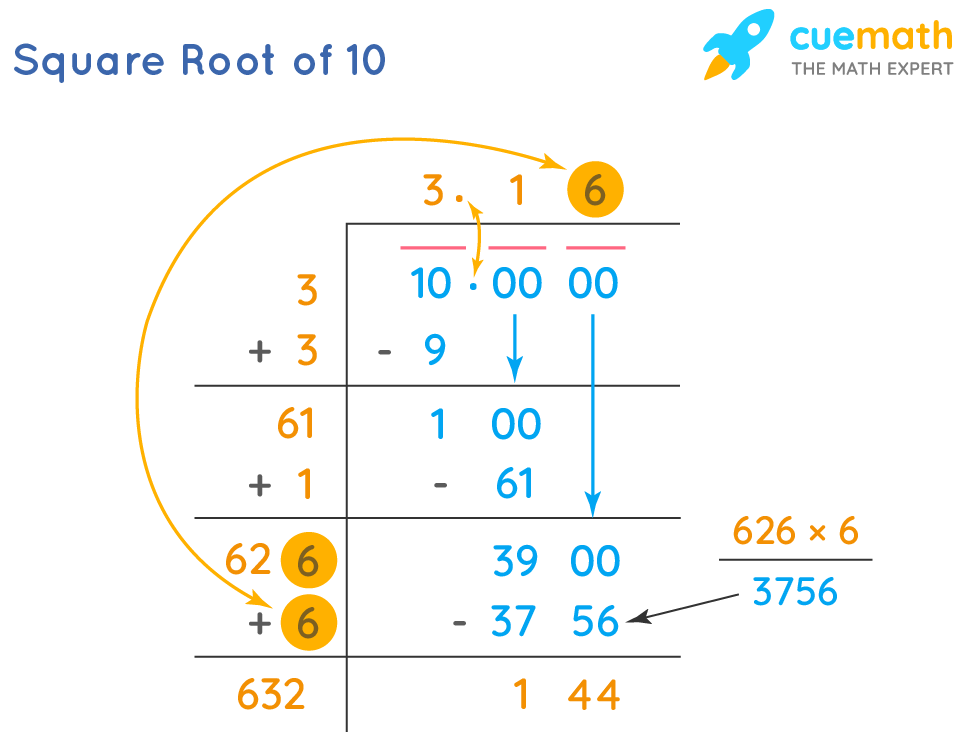Square Root of 10
The square root of 10 is expressed as √10 in the radical form and as (10)½ or (10)0.5 in the exponent form. The square root of 10 rounded up to 10 decimal places is 3.1622776602. It is the positive solution of the equation x2 = 10.
- Square Root of 10: 3.1622776601683795
- Square Root of 10 in exponential form: (10)½ or (10)0.5
- Square Root of 10 in radical form: √10
| 1. | What Is the Square Root of 10? |
| 2. | Is Square Root of 10 Rational or Irrational? |
| 3. | How to Find the Square Root of 10? |
| 4. | Tips and Tricks |
| 5. | Challenging Questions |
| 6. | FAQs on Square Root of 10 |
What Is the Square Root of 10?
The square root of any number n can be written as √n. This indicates that there is a number a such that:
- a × a = n
Now, it can also be written as:
- a2 = n
- a = √n
Here, a is called as the square root of n. Now, if n = 10, then a = √10 is the square root of 10.
- The square root of 10 is 3.16227.
Is the Square Root of 10 Rational or Irrational?
The square root of 10 is an irrational number with never-ending digits. The square root of numbers which are perfect squares like 9, 16, 25, and 100 are integer numbers, but the square root of numbers which are not perfect squares are irrational with never-ending digits. The value of the square root of 10 in decimal form is 3.16227... The square root of any number has two values; one is positive and the other is negative.
- √10 = 3.16227 and √10 = - 3.16227
How to Find the Square Root of 10?
The square root of 10 or any number can be calculated in many ways. Here are two methods: approximation (Hit and Trial) and long division method.
Let's see how to find √10 by approximation method:
- √9 < √10 < √16
- 3 < √10 < 4
Multiply each by 10.
- 30 < 10 √10 < 40
- √900 < 10√10 < √1600
Let's move closer to the inequality.
- √961 < 10√10 < √1024
- 31 < 10√10 < 32
Divide each by 10.
- 3.1 < √10 < 3.2
Take the average of both lower and upper limits.
- √10 approx. = (3.1+3.2)/2
- √10 approx. = 3.15
Square Root of 10 By Long Division
The long division method helps us find more accurate values of the square roots of any number. Let's see how to find the square root of 10 using the long division method.
- Step 1: Divide the number 10 by 3 (because 32 = 9 is a perfect square number less than 10)
- Step 2: Take the same divisor 3 as the quotient. Multiply the quotient and the divisor and subtract the result from 10.
- Step 3: Take the same quotient 3 and add with the divisor 3.
- Step 4: Add a decimal point after the quotient 3 and bring down two zeros and place it after 1 so that it becomes 100. We need to find a digit which, when placed at the end of 6 and multiplying the resultant number with the same digit, gives a number less than 100.
61 × 1 = 61
Subtract 61 from 100.
100 - 61 = 39 - Step 5: Bring down two zeros again and place it after 39, so that it becomes 3900. Take 1 and add it to 61. 61 + 1 = 62. We need to again find a number that when placed at the end of 62 and when the result is multiplied with the same number, we get a number less than 3900.
626 × 6 = 3756 - Write the same number after 1 in the quotient. Subtract 3756 from 3900.
3900 - 3756 = 144

- Step 6: Repeat the process until we get the remainder equal to zero.
The square root of 10 up to two places is obtained by the long division method.
Explore square roots using illustrations and interactive examples
Tips and Tricks:
- Use the hit and trial method while calculating the square root of any number.
- The square root of any number can be assumed as the number between the square roots of the two nearest perfect squares of that number.
For example, square root of 54 lies between the square roots of 49 and 64.
i.e. √49 < √54 < √64
7 < √54 < 8 - Square root of a number n can have two values ±√n
Challenging Questions:
- Find the square root of 1000 by approximation method.
- Find the square root of 10000 by long division method.
Square Root of 10 Solved Examples
-
Example 1: Joseph, a salesman, wants to build a rectangular floor garage to store goods for his shop. He wants the floor to be of length 20 feet and width 10√10 feet. If he has to paint the floor at $10 per square feet, how much money would he have to pay?
Solution
Length of the rectangle floor = 20 feet
Width of the rectangle floor = 10√10 feet
Area of the floor will be = Length × Width
= 20 × 10√10
= 200√10
= 200 × 3.162
= 632.4 feet2
Cost of painting the floor = 10$ / feet2
Total Cost = 632.4 × 10
Total Cost = $6324
Joseph has to pay $6324. -
Example 2
Help Joseph evaluating the value of √10 × √10 × √10
Solution
The value of √10 = 3.16227
Value of √10 × √10 × √10 = 31.6227 -
Example: If the area of a square is 10 in2. Find the length of the side of the square.
Solution:
Let 'a' be the length of the side of the square.
⇒ Area of the square = a2 = 10 in2
⇒ a = ±√10 in
Since length can't be negative,
⇒ a = √10 = 3.162 in

FAQs on the Square Root of 10
What is the Value of the Square Root of 10?
The square root of 10 is 3.16227.
Why is the Square Root of 10 an Irrational Number?
Upon prime factorizing 10 i.e. 21 × 51, 2 is in odd power. Therefore, the square root of 10 is irrational.
What is the Square Root of -10?
The square root of -10 is an imaginary number. It can be written as √-10 = √-1 × √10 = i √10 = 3.162i
where i = √-1 and it is called the imaginary unit.
What is the Value of 12 square root 10?
The square root of 10 is 3.162. Therefore, 12 √10 = 12 × 3.162 = 37.947.
Evaluate 13 plus 12 square root 10
The given expression is 13 + 12 √10. We know that the square root of 10 is 3.162. Therefore, 13 + 12 √10 = 13 + 12 × 3.162 = 13 + 37.947 = 50.947
What is the Square of the Square Root of 10?
The square of the square root of 10 is the number 10 itself i.e. (√10)2 = (10)2/2 = 10.
visual curriculum